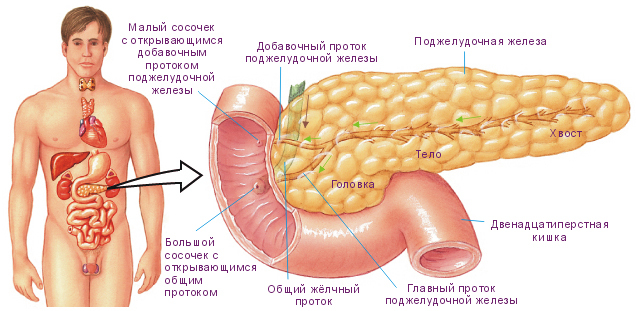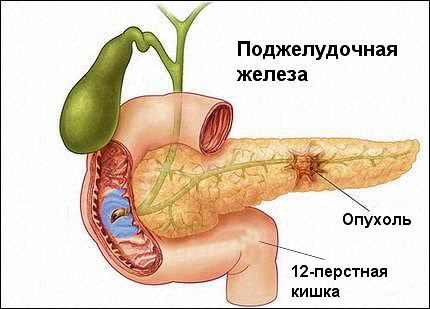Pancreatic ducts: the structure and location of the organ, structure, system, size, anomalies, expansion
One of the causes of disorders of the digestive tract is the pathology of the pancreatic duct system. This system is a complex branched structure that ensures the delivery of pancreatic juice into the intestinal lumen.
The ducts of the pancreas can have congenital abnormalities that lead to dysfunction of the organ. In addition, they are often affected by inflammation, trauma, tumor, pathology of other organs of the digestive system. Diagnostic methods that exist today make it possible to assess the size, topography of the pancreas and its ducts, and to identify deviations from the norm.
Content
-
1 General information about the organ
- 1.1 The structure and location of the organ
- 1.2 Pancreas structure
- 1.3 Pancreatic duct system
- 1.4 Normal dimensions of the outlet ducts
- 1.5 Where do the ducts of the gland and liver open
- 2 Duct abnormalities and dilatation
General information about the organ
Pancreas refers to the endocrine and digestive systems at the same time, since it performs the functions of internal and external secretion.
Due to the exocrine function, pancreatic juice is secreted into the duodenum, which is necessary for the assimilation of proteins, fats, and carbohydrates from food.
Internal secretion is provided by endocrine cells located between the lobules of the gland in the islets of Langerhans. They produce insulin and glucagon, hormones that maintain blood glucose balance.
The structure and location of the organ
Anatomically organ situated in the retroperitoneal space. In front of him is the stomach. On the right, it is closely adjacent to the bend of the duodenum. In an adult, the length of an organ can reach 22 cm, while it weighs no more than 80 g.
The gland is oblong with:
- wide right section - the head;
- the main part is the body;
- the narrow part - the tail.
The head is separated from the body by a groove with a portal vein passing through it. The main pancreatic duct (GLP) forms in the tail, passing through the body, head, and collecting digestive juice from second-order collectors. The accessory duct is located in the head of the organ.
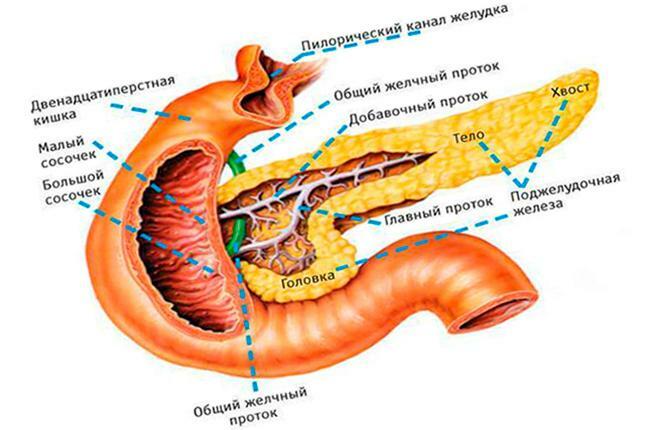
Pancreas structure
The organ has a lobular structure. The main structural element of the exocrine part is the acinus. It consists of secretory and ductal cells. The secret formed in the acini contains:
- water;
- electrolytes;
- several types of amylases (for the breakdown of carbohydrates), lipases (for the assimilation of fats);
- inactive forms of proteolytic enzymes.
Pro-enzymatic forms do not have a destructive effect on the structural proteins of the gland. Their activation begins in the intestinal lumen when interacting with enterokinase, a compound present in parietal mucus. The sphincters in the canal orifices prevent the reverse flow of intestinal contents. In addition, the epithelium of the pancreatic ducts is covered with a layer of mucopolysaccharides. However, with pancreatitis defense mechanisms are disrupted, and enzymes begin to break down the organ's own proteins.
Pancreatic duct system
The pancreatic duct system is responsible for the delivery of enzymes from the acini to the duodenum. It begins with the interlobular tubules, which unite in the interacinous and interlobular ducts, which flow into the main pancreatic collectors.
An amazing feature of the organ is that it is formed from two parts that have grown together during the embryonic period of development:
- upper (dorsal);
- lower (ventral).
This explains the complexity of the duct system.
Large channels pass through the thickness of the organ:
- chief (wirsung);
- additional (Santorini);
- the duct of the uncinate process (this section is present in about 70% of people).
The pancreatic ducts are variable. There are two main types of structure of the duct system:
- main, which is characterized by a small number of second-order ducts - from 15 to 32, with a distance between them of about 0.6-1.4 cm;
- loose, when the intervals between the channels flowing into the GPP are much smaller - up to 2 mm, and their number reaches 50.
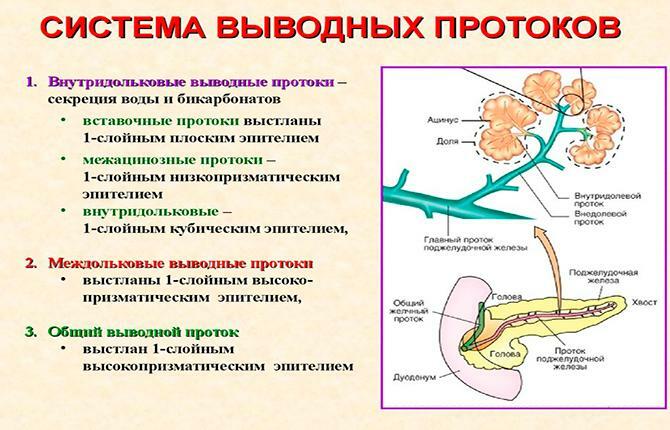
The GLP begins in the tail and ends with the mouth on the large duodenal papilla (Vater nipple). An additional collector collects pancreatic juice from the ducts of the head and opens on the small papilla. In most cases, anastomoses form between both collectors. If the accessory canal is obliterated, pancreatic juice is secreted only through the Wirsung duct.

Normal dimensions of the outlet ducts
The length of the Wirsung duct in an adult is 18-20 cm, the diameter increases from the tail to the head from 1 to 3-4 mm. The dimensions of the accessory duct are variable. In some cases, it is not detected.
Where do the ducts of the gland and liver open
Most often, the GLP merges with the common bile duct, forming the ampulla of the Vater nipple. It opens on the large papilla of the duodenum. Less often, both channels open separately, and their openings are located at a small distance from each other.
The accessory duct ends with a separate opening on the lesser duodenal papilla.
Duct abnormalities and dilatation
Among the congenital anomalies of the ducts of the gland, there are several options:
- formation anomalies with complete or partial splitting of the pancreas;
- anomalies in which the Wirsung duct has the shape of a loop or spiral;
- narrowing of the ducts;
- bifurcation of the duct in any area;
- congenital cysts;
- atrophy of the distal part of the main duct, when the drainage role is played by an additional canal.
In addition, the absence of any connections between the main and accessory ducts when they are completely isolated from each other is considered abnormal.
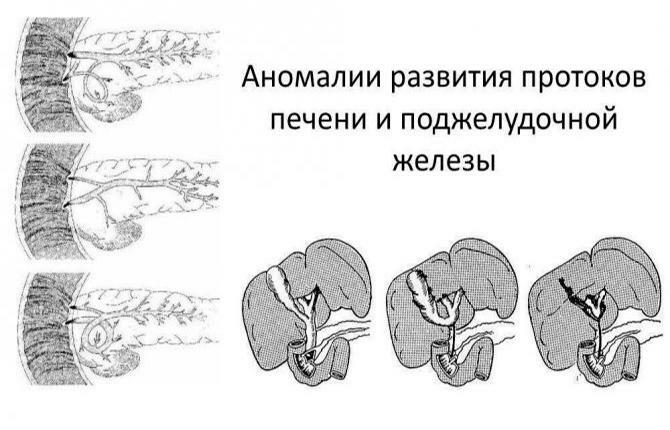
As a result of inflammatory or neoplastic processes, the ducts can be deformed - narrowing of the areas and / or expansion (dilatation) of the ducts. When a canal expansion is detected, differential diagnosis is carried out between several pathologies:
- Chronic pancreatitis.
- Pancreatic duct carcinoma.
- Presence of calculi obstructing the common bile duct.
- Intraductal papillary mucinous tumor.
In pancreatitis, one of the main factors of pathogenesis is the premature activation of proteolysis enzymes. Damage to the epithelium of the pancreatic ducts leads to fibrosis, local narrowing. Violation of the outflow of juice can lead to an increase in intraflow pressure. The increase in hypertension leads to expansion and further damage to the structure of the ducts.
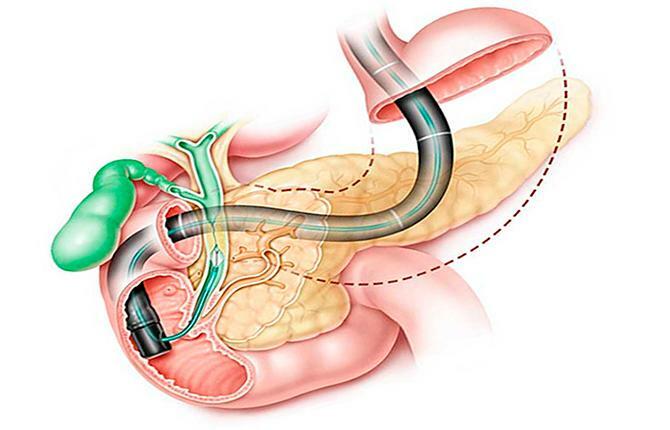
Diagnostics of pathologies of the pancreas (endoscopy)
Magnetic resonance cholangiopancreatography and retrograde cholangiopancreatography can be used to determine the type of duct system, to identify abnormalities and canal dilatation. The second method is the most informative - it not only helps in diagnostics, but can also be supplemented with an endoscopic treatment procedure if necessary. Medical care for the pathology of the pancreatic ducts consists in the treatment of diseases leading to a change in the diameter of the canals, and in performing surgical interventions.
Have you ever encountered pathologies of the pancreatic duct system? Leave comments on the article, add the page to bookmarks, repost on social networks.
Pancreas anatomy in the video.
Literature:
- The architectonics of the pancreatic ducts on autopsy material. Setdikova G. R., Paklina O. V., Bedin V. IN. And etc. 2018 year.
- Regularities of the topography of the pancreas and its structure E.G. Starodubtsev Medicine 2001.
- Ultrasound diagnostics Abdominal and pelvic organs. Aya Kamaia, Jade Won-Yu-Chon 2018.


